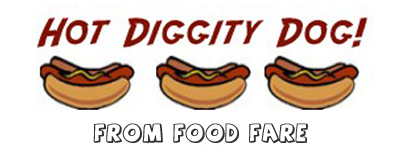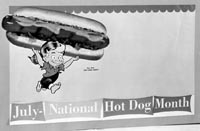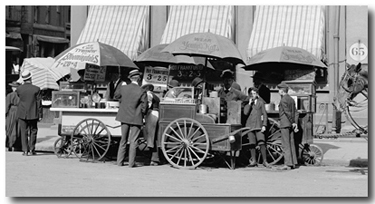|

Click here for Site Menu
July is National Hot Dog Month. Americans will consume an estimated
seven billion hot dogs between Memorial Day and Labor Day. However, the biggest
hot dog day of the year is the fourth of July, when a reported 150 million of
the franks are eaten. On average, one person alone devours up to sixty hot dogs
per year. In 2022, Americans spent more than $8.3 billion on hot dogs in grocery
stores. Los Angeles rates number one in consumption, its residents taking in 30
million pounds of frankfurters in 2022 alone.
The United States Chamber of Commerce officially designated July as
National Hot Dog Month in 1957. The tradition has been going strong ever
since.

Hot dogs are vastly underrated. There are many
ways in which to prepare dogs. Nowadays they are also made with different
variations of meat: beef, and mixes of pork, chicken and turkey. Depending on
your degree of hot-dog-expertise, this universal bite is also known as wieners,
dogs, red hots, franks or frankfurters.
I like a plain hot dog, preferably made with pork
and chicken, on a bun
with little or no ketchup. On the other hand, some people like their dogs loaded
with a variety of condiments. Depending on where you live, there are also a
variety of "specialty" dogs.
Article Contents:
A
Bit of History
How Are Hot Dogs Made?
Types of Dogs, Cooking & Condiments
Hot Dogs & Health
Hot Dogs Around the World
Hot Dog Etiquette
Recipes
Hot Dog Links
Credits & Terms of Use
A
Bit of History
There is a bit of disagreement in
history as to where and when hot dogs originated. Natives in Frankfurtum-Main,
Germany claim they discovered the hot dog in 1487. Then again, others argue it
was created in the late 1600's by Johann Georghehner, a butcher from Coburg who
is said to have traveled to Frankfurt to promote his new product known as a
"little dog" sausage. The town of Vienna, Austria also claims to have invented
the hot dog.
Weinerwurst was the original
name of the "wiener" (which translates from German into Vienna sausage). Another German reference to the food was
bundewurst, which was dog sausage, or smoked sausage. By the 1920's,
weenie roasts had become a favorite pastime, with guests often bringing their
own hot dogs to roast over an open fire. Oscar Mayer had the first portable hot
dog cart in 1936, calling it the Wienermobile.
Eating the hot dog in a warmed bread
bun with various condiments is credited to Charles Feltman of Feltman's Gardens
in the Coney Island amusement park. He opened the first "hot dog" stand in 1871,
which were known as "dachshunds" at the time. Feltman sold 3,684 of the dogs wrapped
in milk buns his first year of business. Corn dogs were introduced by Texan
native Neil Fletcher at the Texas
State Fair in 1942.

(Above): Hot dog stand
in New York City (1906), when hot dogs were priced at 3-cents each.
The actual term hot dog is
attributed to sports cartoonist T.A. Dorgan. He was present at the Polo Grounds
in New York during a 1901 baseball game and heard vendors yelling "Get your
dachshund dogs while they're red hot!" Dorgan sketched a cartoon depicting the
scene, but was unsure how to spell "dachshund." Instead, he simply used the term
"hot dogs." Later, Dorgan's "sausage" cartoons maligned the inexpensive wieners
sold at Coney Island, hinting they contained dog meat. The publicity was so
ferocious in 1913 that the Chamber of Commerce banned the use of the term hot dog
from signs at Coney Island. The term first appeared in the pages of the Oxford
English Dictionary in 1900.
^ Back to top of page ^
How
Are Hot Dogs Made? (Or Do You Really Want To Know?)
There have been many stories about
the meat origins of hot dogs, some of them none-too-appetizing. Years ago
someone told me hot dogs and bolognas were made with various body parts from
horses, which naturally turned my stomach. In reality, selected meat
trimmings of beef and/or pork are cut and ground into small pieces and placed
into a mixer. In the event "chicken" hot dogs are being made, poultry trimmings
are used.
Stainless steel choppers blend the meat, spices,
ice chips and curing ingredients at a high speed until they are emulsified, or
reach the consistency of batter. The mixture is weighed constantly to ensure a
proper balance of all ingredients. It is then pumped into an automatic linker
machine, where it flows into casings. Most hot dogs are made using cellulose
casings later removed, while other producers use natural casings made from
animal intestines, which remain on the hot dog when it is finally eaten. Once
the casings are filled, they are linked into long strands of hot dogs and fully
cooked in a smokehouse. After the cooking process, the hot dogs are sprayed with
cool water. If made with cellulose casing, the hot dogs are then placed on an
automatic peeler, where the skin is stripped away.
 Individual links are then
vacuum-packed in plastic films to protect freshness and flavor. Each package
will contain an "ingredient" statement, which lists contents in the
product. It is now less common to use "variety" meats such as beef and pork
hearts in hot dogs, but if they are used, the label should be clearly marked
with the term "made using variety meats" or a similar statement. The
manufacturing of hot dogs is also closely regulated and inspected for
wholesomeness by the U.S. Department of Agriculture. Individual links are then
vacuum-packed in plastic films to protect freshness and flavor. Each package
will contain an "ingredient" statement, which lists contents in the
product. It is now less common to use "variety" meats such as beef and pork
hearts in hot dogs, but if they are used, the label should be clearly marked
with the term "made using variety meats" or a similar statement. The
manufacturing of hot dogs is also closely regulated and inspected for
wholesomeness by the U.S. Department of Agriculture.
-
Beef (contains only beef with no
soybean or dry milk fillers).
-
Kosher (all-beef, seasoned with
garlic).
-
Meat (a mix of pork and beef, no
fillers).
-
Frankfurter (can contain a percent of
fillers made from a combination of meats).
Types of Dogs, Cooking & Condiments
-
Baltimore Frizzled (split and deep
fried).
-
Chicago Dogs (with yellow mustard,
dark green relish, chopped raw onions, tomato slices, celery salt and a
poppy-seed bun).
-
Chili Dogs (cooked hot dogs smothered
with chili and onions).
-
Coney Island Dogs (topped with a
spicy meat sauce).
-
Corn Dogs (hot dogs on a stick dipped
in corn batter and deep fried).
-
Kansas City Dogs (with sauerkraut and
melted Swiss cheese on a sesame seed bun).
-
Lillies (cocktail-sized wieners
served with sauce).
-
Montreal Hot Dogs (Quebec specialty with
coleslaw, mustard and onion; also known as "Steamies").
-
New York City Dogs (with steamed
onions and a pale yellow mustard sauce).
-
Pigs-in-a-Blanket (wrapped in pastry
and baked).
-
Potato Hot Dogs (topped with mashed
potatoes and American cheese).
-
Southern Slaw Dogs (with coleslaw).
-
Tex-Mex Dogs (with salsa, Monterey
Jack cheese and chopped jalapeno peppers).
-
Vienna Sausage (mini-hot dogs in a
flavored juice).
Hot dogs are typically fully cooked
when packaged, but in America it is customary to warm them first before eating.
The flavor of the dogs improves a great deal upon "warming." Favorite
cooking methods include boiled, broiled, braised, baked, grilled, fried, and
steamed in beer or other liquids.
Anyone who likes hot dogs has a preference of
condiments. "Dressing" the dog is solely up to the individual, but the National Hot Dog & Sausage Council
recommends the following order for condiment "application": wet (mustard
or ketchup), chunky (relish, onions or salsa) and lastly
cheese, with spices if desired. Some children are known to like chocolate on
their dogs as well.
And remember: Dress the dog and not
the bun! This is firmly reiterated in Hot Dog
Etiquette.
^ Back to top of page ^
Hot
Dogs and Health
The majority of hot dogs are high in fat. Almost
all contain sodium nitrite, a chemical salt used as a preservative and
flavor enhancer, which some researchers claim are carcinogens. Some consumers
allege other health problems, such as sudden drops in blood pressure. However,
those who are serious about their fat intake can select from a variety of
low-fat and fat-free wieners, or switch to vegetarian tofu franks.
Chicken or turkey dogs are not always
lower in fat, so be sure to check the nutritional information on the package.
Surprisingly, however, hot dogs can also be good sources of vitamins, minerals
and protein including iron, zinc, niacin, riboflavin and B vitamins.
Hot
Dogs Around the World
The American hot dog now enjoys worldwide
popularity. In Russia, hot dogs are known as sosiska. Just a few years
ago, hot dog sales in Russia totaled more than $70 million. Russians prefer
spicy dogs, often made with large amounts of garlic. In China, hot dogs are
called Rouchang. They are served fully cooked although cold, wrapped in
red plastic. Chinese dogs are eaten in similar fashion to a popsicle: the red
wrapping slowly peels away as the dog is consumed.
In other countries, the hot dog is
also known as:
-
Perrito Caliente (Spain)
-
Caldo Cane (Italian)*
-
 Chien Chaud (France) Chien Chaud (France)
-
Heisser Hund or Wurst (Germany)
-
Cachorro Quento (Portugal)
-
Korv or Varmkorv (Sweden)
-
Grillpolser (Norway and Denmark)
-
Park v Rohliku (Czechoslovakia)
-
Worstjes (Dutch)
-
Makkarat (Finland)
*Note:
According to the
National Hot Dog & Sausage Council, the Italian name for hot dog is "caldo cane." However, I
recently received a message from a reader who stated no one in Italy says "caldo
cane" as it is used for word translation and in literal terms means something
similar to a "warm pet." Italians do not translate the word. It is merely said
as "hot dog" (in the plural and singular; it is invariable) or "otdog"
because the "H" pronunciation is silent. Thanks to Marco for the information and
the direct quote.
^ Back to top of page ^
Hot
Dog Etiquette
The following etiquette applies to the "art" of eating a hot
dog per the National Hot Dog & Sausage Council:
-
 Condiments remaining on the fingers
after eating a hot dog should be licked away, not washed. Eat hot dogs on buns
with your hands. Utensils should never touch hot dog buns. Condiments remaining on the fingers
after eating a hot dog should be licked away, not washed. Eat hot dogs on buns
with your hands. Utensils should never touch hot dog buns.
-
Use paper plates to
serve hot dogs - china plates are forbidden.
-
Do not leave bits of bun on your
paper plate - eat it all!
-
Do not use a cloth napkin to wipe your mouth when
eating a hot dog. Paper napkins are always preferred.
-
Do not place hot dog
toppings between the hot dog and the bun. Always "dress the dog," not the bun.
FOOD FARE RECIPES:
Baguette Franks
Chicago Dogs
Coney Island Dogs
Corn Dogs
Homemade Frankfurters
Montreal
Hot Dogs
Mummy
Dogs
Pigs-in-a-Blanket
Potato Hot Dogs
^ Back to top of page ^

Hot
Dog Links
Hot Dog Month at
Holiday Spot
Hot Dog on a Stick
National Hot Dog & Sausage Council
The Hot Dog
Credit & Terms of Use
(C)
Shenanchie
Reprinted exclusively for Food Fare
 "Hot Diggity Dog"
was written for entertainment purposes only and expresses the sole opinions of
the author. This article is not meant to be a professional chef's essay about
hot dogs, but rather an observation about the generalities of frankfurters from
a home kitchen. "Hot Diggity Dog"
was written for entertainment purposes only and expresses the sole opinions of
the author. This article is not meant to be a professional chef's essay about
hot dogs, but rather an observation about the generalities of frankfurters from
a home kitchen.
You are free to use the material in this article as reference, but if you
happen to use direct wording from this piece, we would appreciate the credit.
Thank you.
To
send Shenanchie a comment about this article, click here.
Photo Credits:
 Hot Dog Stand
(1906, NYC): Issued by the US Library of Congress (digital ID
det.4a13502). Original photo from the Detroit Publishing collection, which
was given to the Library of Congress by the State Historical Society of Colorado
in 1949. There are no copyright restrictions on the photo as it was published
prior to 1922. Hot Dog Stand
(1906, NYC): Issued by the US Library of Congress (digital ID
det.4a13502). Original photo from the Detroit Publishing collection, which
was given to the Library of Congress by the State Historical Society of Colorado
in 1949. There are no copyright restrictions on the photo as it was published
prior to 1922.
American Food &
Culture
"Hot Diggity Dog" also appears as a chapter in the
book American
Food & Culture, which is part of Food Fare's exclusive Culinary
Collection. Click here for more >

Food Fare Site Menu:

Colored background
tiles:
Backgrounds
by Marie
^ Back to top of page ^
|